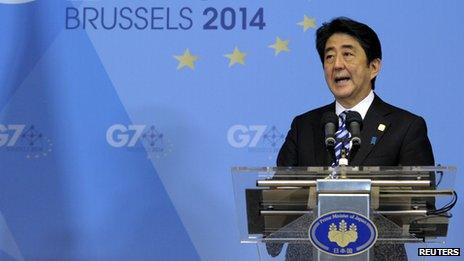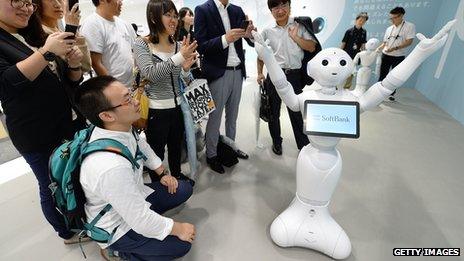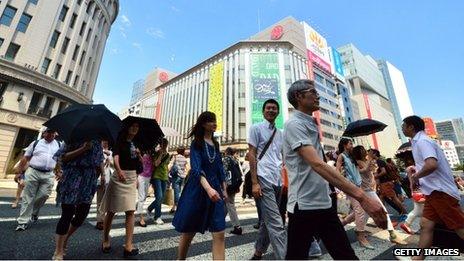Do the latest economic reforms mean that 'Japan is back'
- Published
- comments

Japan's Prime Minister Shinzo Abe's structural reforms comprise the third arrow which lies at the heart of his economic reform policy dubbed Abenomics - the first two arrows fired were monetary and fiscal policies.
These deep reforms to the way that the Japanese economy operates are crucial to getting growth going. Will he do enough to show that "Japan is back"?
That was his promise as he has sought to revive Japanese growth since taking office 18 months ago. Recall that Japan was the economy poised to overtake the US before the 1991 crash.
Japan grew at an impressive 4% on average during the 1980s before the real estate bubble burst.
Mr Abe isn't aiming for that rapid pace but for growth of 2%. That's a modest growth rate for an advanced economy, but would double the pace since the crash.
It's a tall order. The OECD estimates that the potential growth of the economy is just 0.75% and points out that Japan has suffered three recessions in the last five years - due to two major shocks of the global financial crisis and the tsunami of 2011.
To raise the growth rate of an economy requires more output through adding more factors and using them more efficiently.
Obstacles ahead
Japan has challenges on both fronts.
In terms of workers, the labour force is estimated to decline by 40% by 2050 which means fewer workers to produce output.
Adding women to the workforce, dubbed Womenomics, would help but a restrictive immigration system limits the other avenue of importing productive workers.
The Prime Minister has announced a relaxation of immigration rules for highly skilled foreign workers but that may not be enough.
Also, he's aiming for a robotics revolution. Robots as workers would be an interesting development.

A rigid employment system also prevents better "matching" of workers to jobs. Better matching of skills to work can raise productivity.
That flexibility, though, also implies higher unemployment as employees seek jobs and are "frictionally" unemployed and employers can hire and fire more freely.
Higher unemployment is never politically easy to accept.
Vested interest
In terms of business, Prime Minister Abe has vowed to tackle special interests and de-regulate.
As the Japanese system has been built on the basis of keiretsu corporate structures with interlinked businesses, transforming it into a more decentralised market with lots of competing firms won't happen quickly and will require taking on some of the most powerful companies to change the way that they operate.
Raising investment is a key way of adding capital that can boost growth. Abe intends to cut the corporate tax rate from over 35% to below 30% and perhaps close to the OECD average of 29%.
Whether taxes are holding back investment is an open question. After all, Japanese firms have high savings rates that they've invested overseas.
Plus, there is a knock-on effect on government revenues that matters as Japan's government debt exceeds 200% of GDP and its primary budget deficit (budget gap minus interest payments) is estimated to be a sizeable 9% of GDP.
Among a slew of announcements, there will also be reforms of the healthcare system and the Government Pension Investment Fund - a sizeable fund of $1.26 trillion that aims to invest more in stocks to better support the greying population.
An attempt to raise a consumption tax to perhaps 10% by next year though has been controversial as the government seeks to raise demand to entice firms to invest and produce at home.

Accurate arrows
Finally, when the first iteration of this plan was unveiled last year, the reaction was lukewarm as lots of the details were left vague and to be implemented.
There's still a sense of that with the formal unveiling of this plan.
This is despite the success so far in the first two arrows. Notably, inflation is still to reach the 2% target but is rising by 1.3%.
Deflation discourages consumers from buying as they put off purchases and thus firms will also not produce more and invest in production, so it is an important target to hit.
Japan has done that through aggressive monetary easing with the central bank injecting cash until the target is met.
Combating deflation requires a change in consumer attitudes and firm behaviour, so it's a more complex process than it appears.
The structural reforms are likely to be even more complex. But, they, and not the first two arrows, will determine whether Japan is truly back.